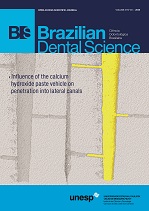Expression of BMP II by human osteoblasts cultivated on dense or porous titanium
DOI:
https://doi.org/10.14295/bds.2018.v21i3.1586Abstract
Objective: To quantified the expression of the morphogenetic bone protein II (BMP II) produced by human cells with osteoblast differentiation, after cultured over dense or porous samples of pure titanium grade II. Material and methods: The samples were produced by powder metallurgy technique. Mesenquimal steam cells isolated from alveolar bone of healthy donors were stimulated to differentiate, assuming an osteoblastic phenotype, by supplemented medium and plated over the samples. The experimental groups were: control, dense titanium, titanium of higher porosity and titanium of lower porosity. After 7 and 14 days, the RNA was extracted. The cDNA was prepared and the polymerase chain reaction (PCR) technique was used in real time, using the constitutive gene Beta-Actin to relative quantification. The pore morphology and interconnection were confirmed by Scanning Electron Microscopy (SEM). Results: Total porosity (obtained after apply dimensions and density formulas) and surface porosity (SEM) presented significant differences among the groups. For the group of total porosity of 33.79%, the superficial porosity was 32.5% (± 7.74%) and for the group of 41.79%, the superficial porosity was 37.4% (± 7.95%), significantly lower. The expression of BMP II was similar in all groups. Conclusion: It was concluded that the powder metallurgy has a reduced ability to standardize the porosity in the samples and that the porosity does not interfere in the cellular response of BMP II production, an important inducer of osteoblastic differentiation.
Keywords
Porous titanium; BMP II; Cell culture; PCR.
Downloads
Downloads
Published
How to Cite
Issue
Section
License
Brazilian Dental Science uses the Creative Commons (CC-BY 4.0) license, thus preserving the integrity of articles in an open access environment. The journal allows the author to retain publishing rights without restrictions.
=================




























